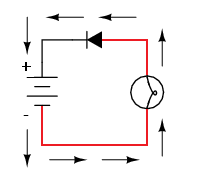Using conventional notation in the diagram below, I understand that the circuit is not complete because the diode is in reverse bias. But knowing that the electrons actually flow from the negative to the positive terminal(direction of the arrows), wouldn't the electrons take a path from the negative terminal of the battery, go through the lamp and stop at the diode(the red path in the picture). If they would, then why doesn't the lamp light up with the first electrons that are able to flow through it before the voltage in the wire is built up and the current stops.
2 Answers
Electrons can't flow in that direction (right to left) though a diode.
Yes, a small transient current flows while the voltage builds up across the diode (it acts like a small capacitor). In practice this charge is very small (pico coulombs), and would not actually illuminate a lamp, neither could you see the extremely brief pulse even if it could.
IF "Using conventional notation" then it needs to be applied to the diode as well. In other words, you need to draw the diode under this convention. (change the diode direction) As you said on the question, electrons does flow from Negative to positive.
(In other words, diode is a diode it does not care which convention or how we chose to draw it, it does what it does best, always!)

